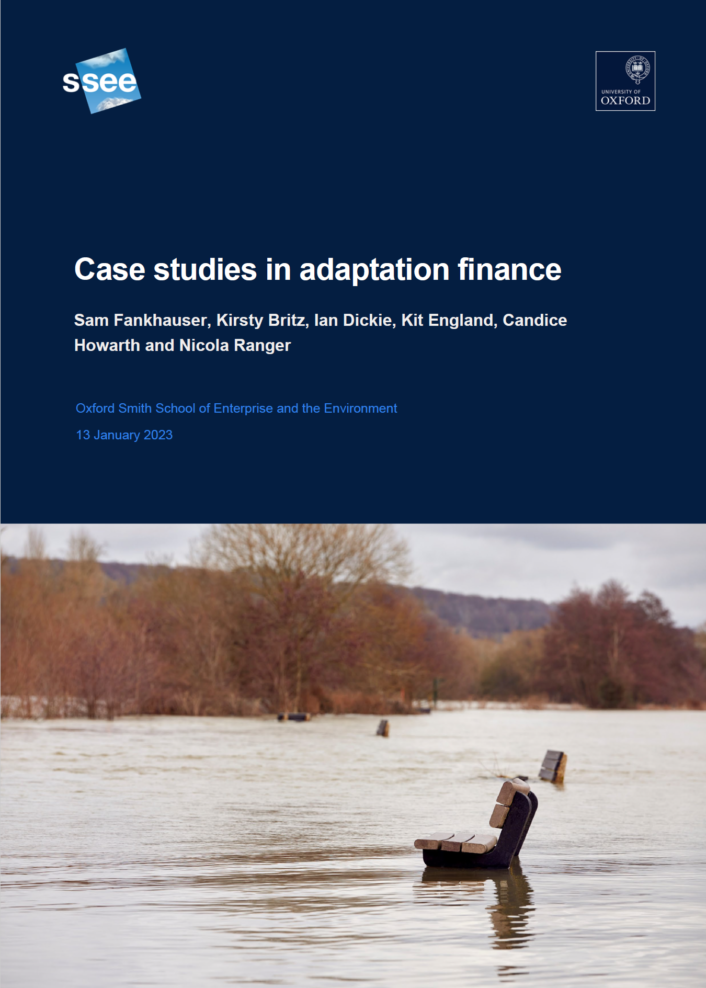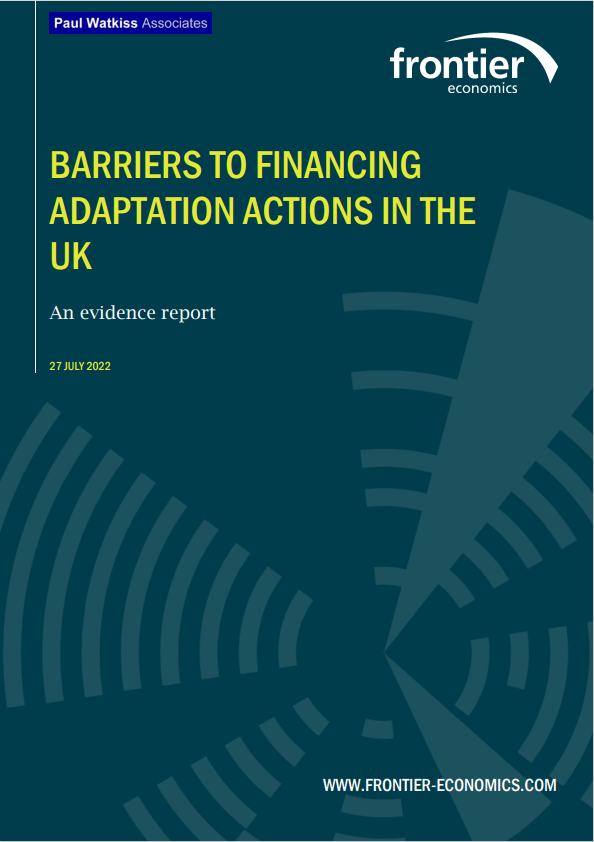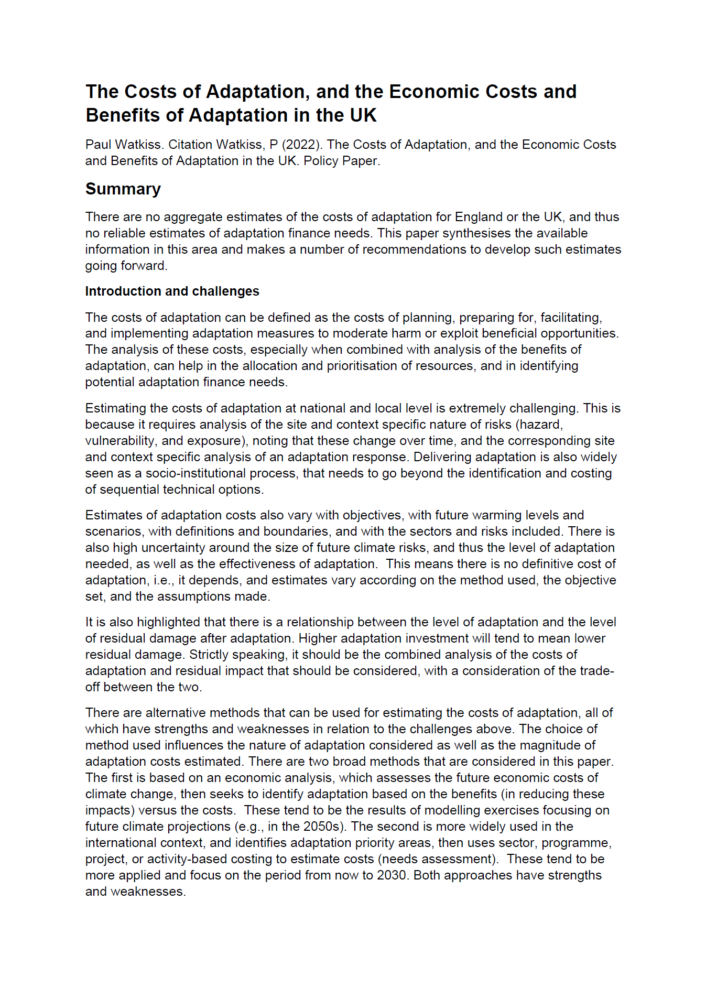1. Outline
The UK’s climate has already changed due to human emissions of greenhouse gases and will continue to change, over the coming decades. Limiting the impacts of these changes on the UK’s ecosystems, infrastructure economy and communities requires targeted actions right across the economy, but the UK is currently falling short of this challenge with gaps in planning and delivering climate resilience across the board.
Proactively building this resilience to climate change will require significant investment. This report lays out where investment will be needed to build climate resilience, the barriers associated with delivering this, and how key investment streams for adaptation can be scaled up.
2. Key messages
- Investment from public and private sectors will be needed to build climate resilience. Currently there are barriers to investment in adaptation, particularly from the private sector which is limiting our ability to prepare for climate change.
- The Government has a critical role in supporting adaptation investment to help the UK build resilience to climate.
- We have identified several areas for targeted action by Government to support investment in adaptation across the economy.
- Clarifying adaptation goals and roles for investment.
- Creating markets that value adaptation outcomes.
- Public sector leadership.
- Strengthen corporate disclosure regimes.
- Empowering financial regulators and public finance institutions to address physical climate risks.
- Helping to unlock investment through public financial institutions.
3. Recommendations
- The forthcoming Third National Adaptation Plan (NAP3) is critical to setting out this vision for what a well-adapted UK looks. NAP3 should set of the vision of what a resilient UK would be like, and back this up with clearly laid out specific and measurable resilience standards and targets.
- The refresh of the Green Finance Strategy in 2023, together with NAP3, should clarify where the Government expects adaptation actions to be funded through public sources and where private investment is expected. NAP3 should contain clear new funding commitments for investment in adaptation over the coming five-year period and the breakdown across department budgets.
- Government should prioritise creating markets for adaptation outcomes across relevant legislation and policy programmes, including initiatives on carbon market integrity and the Environmental Land Management Schemes.
- The need for investment in adapting to climate change should be included within mandates/strategic priorities for all relevant regulated industry regulators and implementing agencies through resilience standards aligned to national-level objectives. There should be a duty for regulators to identify and create climate adaptation project pipelines, aligned with national adaptation objectives, and to set out how they will enable the realisation of that pipeline.
- The Office for Budget Responsibility should undertake a full review of how the impacts of climate change in the UK will affect the UK’s macroeconomic performance and public finances, building on the analysis in their 2021 Fiscal Risks Report, to enable a full-cost benefit analysis for public investment in adaptation.
- Government and its implementing agencies should ensure that a growing fraction of their funding helps to support pioneering projects that seek to provide proof of concept for successful funding and delivery of adaptation actions through public-private partnership funding and financing.
- The update to the Green Finance Strategy in 2023 and NAP3 should set out steps to ensure that the UK SDR initiatives (including the Green Taxonomy) are effective in improving our understanding of adaptation investment needs, directing finance towards adaptation and ensuring that regulators and auditors have the necessary expertise to monitor the quality of reporting and provide incentives for organisations to report on their adaptation actions.
- The UK should build on the work of the Transition Plan Taskforce (on corporate transition plans, including for net zero and wider sustainability objectives) to define common standards for what high-quality adaptation plans should look like. This should include how relevant physical climate risks are measured and managed as well as how the plans would contribute to wider societal adaptation to climate change.
- Financial regulators should provide directional guidance for financial institutions to measure physical climate risk and their contribution to climate adaptation (and maladaptation) outcomes across portfolios and loan books. This should be integrated into required climate related disclosures as part of SDR, as well as enforced through microprudential supervision. The interdependencies between physical, transition and liability risks must be considered for scenario analysis and stress testing. Stress testing of the financial system to climate change risks should be done regularly as data and methodological approaches improve our understanding of the risks and impacts.
- UK Public financial institutions (such as the UK Infrastructure Bank, British Business Bank, UK Export Finance, and British International Investment) – should create adaptation finance strategies, setting out they will independently and collectively ensure that no viable UK climate adaptation project fails for lack of finance.
- UK public financial institutions should launch new sustainability-linked instruments tied to adaptation outcomes to help prime the market, potentially by offering guarantees to private issuers and lenders for adaptation-linked instruments.
4. Supporting research
Topics





